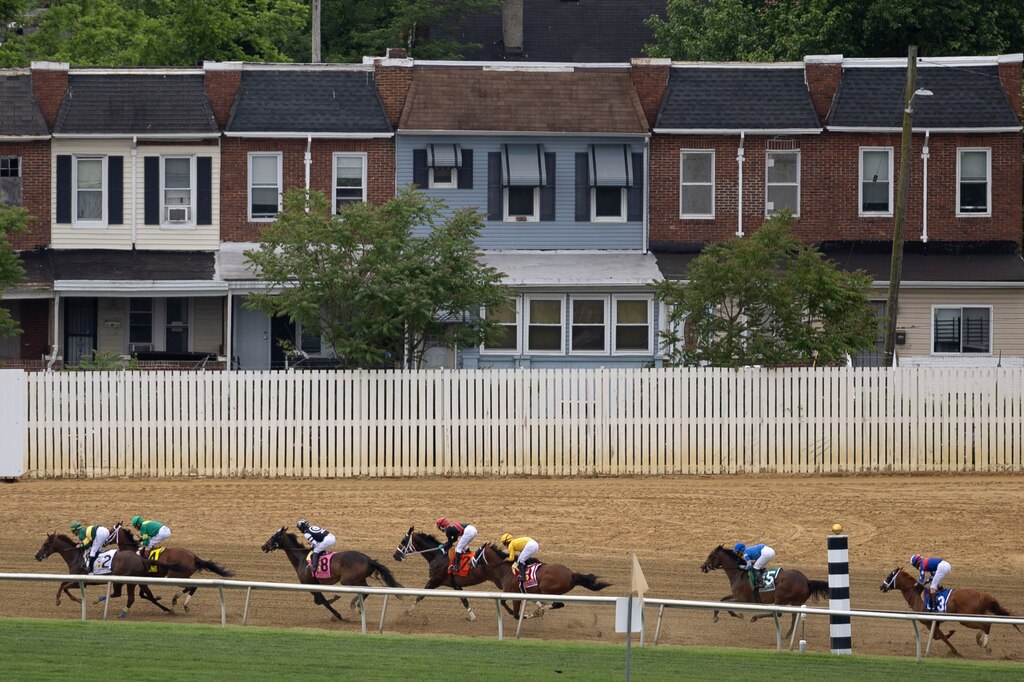For the past few years, politicians have smiled for the cameras and pressed the flesh at Pimlico Race Course on the third Saturday in May, but they’ve done so with an unease about the future of the historic track and the thoroughbred racing industry.
This year, they had reason for guarded optimism. The state government is poised to take ownership of Pimlico and assume responsibility for running races at the track, which will be the focus of year-round racing in the state.

“In years past, there’s been uncertainty. I think this year it’s more celebratory,” said Gov. Wes Moore, who recently signed off on a new law and a set of legal agreements necessary for the deal to happen.
He added: “I think people know that this time, in this administration, we got it right. We’ve helped to save not just an industry but do it in a way that honors the business community and do it in a way that actually honors the entire Park Heights community, as well.”
Under the deal, dubbed “Pimlico Plus,” the Stronach Group will transfer Pimlico to the state for $1. The state will own the dilapidated track, redevelop it with state-backed bonds and create a nonprofit entity to run thoroughbred horse races there year-round.
During construction, racing will move to Laurel Park in Anne Arundel County, but ultimately that track will close and Stronach will retain ownership of the land.
As Stronach exits the thoroughbred racing industry in Maryland, the company will continue to make money from it. Stronach will continue to own the rights to Preakness, and the state will pay Stronach an annual license fee of $3 million plus 2% of the gross betting handle for the weekend.
The deal includes $10 million worth of housing and community development money for Park Heights, and plans are being drawn up for how to use it.
Malcolm Ruff, a state delegate who grew up in West Baltimore, was among officials expressing optimism Saturday.
“This is a dreary, rainy day, and yet people are braving the rain, the wet, the mud,” said Ruff, a Democrat. “We all are feeling the momentum behind what we’re here to do, which is to reinvigorate horse racing while also reinvigorating this neighborhood.”
For years, Ruff said, the community has felt cut off from the racetrack and Preakness festivities. The events have been something happening in their community but not something for the community, he said. That’s about to change.
“We’re changing the narrative of this being a race that is insulated from the Park Heights community to be a race that reflects all of the many different cultures, the many different aspects of our state and especially West Baltimore,” he said.
The Pimlico Plus deal represents the latest effort to keep thoroughbred horse racing alive in Maryland. For decades the racing industry has regularly found itself on the precipice of failure. The aging tracks have become more dilapidated, the Stronach Group asserted it was losing money, and some feared the Preakness Stakes — a historic and beloved sporting tradition — might disappear or move.
“I think it’s really one of those situations where it’s a win-win-win for everybody involved, and it paves the way for the future,” Belinda Stronach, CEO of the Stronach Group, said this week.
The last rescue plan, hatched in 2019, never came to fruition due to a combination of pandemic delays, inflation and an unanticipated tax hit to Stronach.
Following that failure, last year Maryland lawmakers created a new entity, the Maryland Thoroughbred Racetrack Operating Authority, and charged it with developing a new plan and negotiating with the Stronach Group to make it happen.
“I feel like we’ve turned a corner,” Greg Cross, chair of the authority, said at the track on Saturday afternoon.
In the coming weeks, the legal transfer of the Pimlico property should be completed, and initial demolition work will begin.
Among the first structures to go: the portions of the old grandstand that have been closed for years — and covered with decorative tarps during Preakness — due to safety concerns. Horse trainers and others are hoping some of the barns, including Stall 40 where the Kentucky Derby winner stays, can be preserved.

The racetrack operating authority will create the new, nonprofit entity that will run day-to-day racing operations at Pimlico. And the Maryland Stadium Authority, which is managing the Pimlico rebuild, is drawing up plans for the renovation.
The work will be paid for with $400 million of state-issued bonds, to be paid back with existing racing subsidies from the state’s casinos and money from the state lottery.
Work will begin in earnest after the 2025 Preakness Stakes. Laurel Park will host the race in 2026, and — if all goes to plan — the new-look Pimlico will reopen in 2027.
Moore said he hopes the new, more certain path for the track and the industry will draw more people to Preakness in the coming years.
In the past, “uncertainty clouded everything,” Moore said. “I think it’s very difficult to get excited about something that you don’t know the future of. ... Now people see that it’s a priority. People see that we’re going to invest in it.”



Comments
Welcome to The Banner's subscriber-only commenting community. Please review our community guidelines.